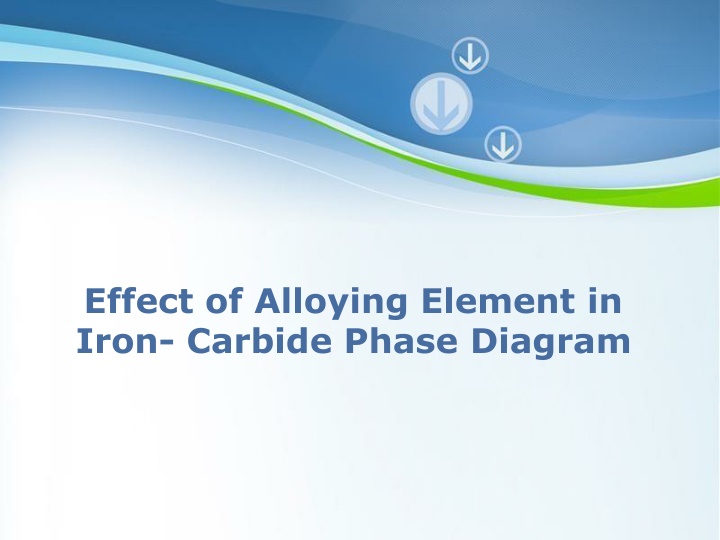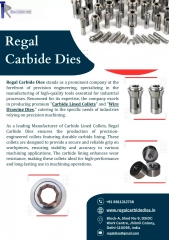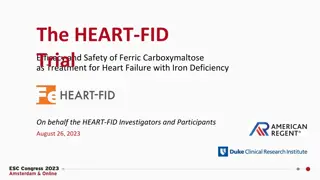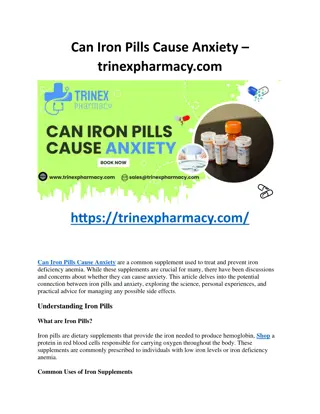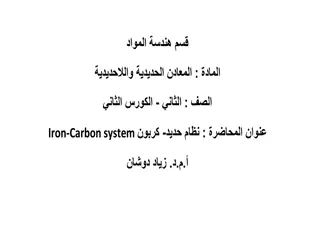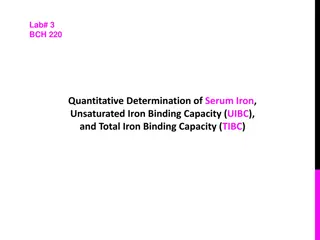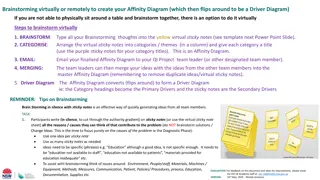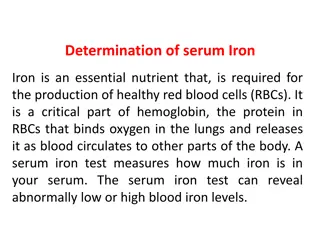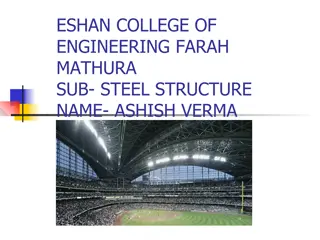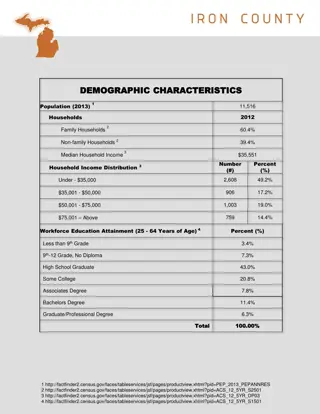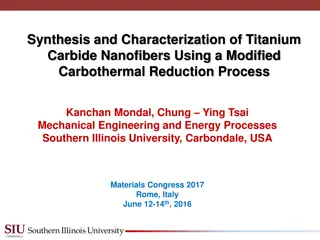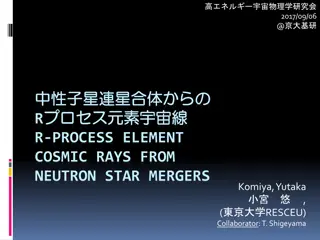Effect of Alloying Element in Iron- Carbide Phase Diagram
Alloying elements play a crucial role in shaping the iron-carbide equilibrium diagram, impacting factors like strength enhancement, carbide formation, critical cooling velocity, and more. This presentation explores the effects of various alloying elements on steel properties and phase transitions, highlighting their influence on temperature ranges, carbon content, and creep strength. Learn why alloying is essential in enhancing steel performance and resistance to corrosion and thermal changes.
Download Presentation

Please find below an Image/Link to download the presentation.
The content on the website is provided AS IS for your information and personal use only. It may not be sold, licensed, or shared on other websites without obtaining consent from the author.If you encounter any issues during the download, it is possible that the publisher has removed the file from their server.
You are allowed to download the files provided on this website for personal or commercial use, subject to the condition that they are used lawfully. All files are the property of their respective owners.
The content on the website is provided AS IS for your information and personal use only. It may not be sold, licensed, or shared on other websites without obtaining consent from the author.
E N D
Presentation Transcript
Effect of Alloying Element in Iron- Carbide Phase Diagram Powerpoint Templates Powerpoint Templates Page 1
Effects of alloying elements Alloying elements have significant effect on the iron-iron carbide equilibrium diagram The effect of the alloying element in the steel may be one or more of thefollowing: (1)It may go into solid solution in the iron, enhancing the strength. (2)Hard carbides associated with Fe,C may be formed. (3)It may form intermediate compounds with iron, e.g. FeCr (sigma phase), FeW. (4)It may influence the critical range in oneor Powerpoint Templates more of the following ways: Page 2
Effects of alloying elements (a)Alter the temperature. For e.g, 3% Ni lowers the Ac points some 30 C, while 12% Cr raises theAc1, temperature to about 800 C (b)Alter the carbon content of the eutectoid: The C content of the pearlite in a 12% Cr steel is 0.33%, as compared with 0.87 in an ordinary steel. Ni also reduces the amount of C in the pearlite and consequently increases the volume of this constituent at the expense of the weaker ferrite. (c)Alter the critical cooling velocity , which is the minimum cooling speed which will produce bainite or martensite from austenite. Powerpoint Templates Page 3
Effects of alloying elements Some alloying elements will widen the temperature range through which austenite is stable while other elements will constrict the temperaturerange. Combinations of elements can be chosen so that the volume change is reduced and also the risk of quench cracking. It may have a chemical effect on the impurities. Under suitable slag conditions vanadium, in quite small quantities, "cleans" the steel and renders it free from slag inclusions. Manganese and zirconiumform sulphides. Some elements (like Al, Cr, Si, Cu) tends to produce adherent oxide film on steel whichresist corrosion and oxidation at elevatedtemps. Powerpoint Templates Page 4
Effects of alloying elements Creep strength may be increased by the presenceof a dispersion of fine carbides, e.g. molybdenum. It may render the alloy sluggish to thermal changes, increasing the stability of the hardened condition and so producing tool steels which are capable of being used up to 550 C withoutsoftening and in certain cases may exhibit an increase in hardness. Powerpoint Templates Page 5
Why we do alloying in steel? Powerpoint Templates Page 6
Effect of alloying elements Fig. Effect of alloying elements on eutectoid temp. and C content Fig. Effect of alloying elements on hardness ofsteel Powerpoint Templates Page 7
Effect of alloying elements Powerpoint Templates Page 8
Effect of alloying elements Fig. Effect of different % of C in the presence of Cr in steel Powerpoint Templates Page 9
Effect of alloying elements Table I Effect of alloying on critical cooling speed on steel Carbon, % Alloying Element, % Cooling Speed toform Martensite, C persec (650 C) 550 0.42 0.55 Mn 0.40 1.60 Mn 50 0.42 1.12 Ni 450 0.40 4.80 Ni 85 0.38 2.64 Cr 10 Powerpoint Templates Page 10
General Trends of alloying Powerpoint Templates Page 11
General Trends of alloying Powerpoint Templates Page 12
Classification of alloying elements Elements which tend to form carbides. Cr, W, Ti, Cb, V , Mo, Zr and Mn. Generally carbide formers are also ferrite formers. M23C6, M6C, etc. The mixture of complex carbides is often referred to as cementite. Elements which tend to graphitise the carbide. Si, Co, Al and Ni. Only a small proportion of these elements can be added to the steel before graphite forms during processing, with attendant ruin of the properties of the steel. Their presents makes the carbides unstable. Elements which tend to form nitrides. Allcarbide Powerpoint Templates forming elements are also nitride former. Page 13
Classification of alloying elements Elements which tend to stabilise austenite. Mn, Ni, Co and Cu. These elements alter the critical points of iron in a similar way to carbon by raising the A4 point and lowering the A3 point, thus increasing the range in which austenite is stable, and they also tend to retard theseparation of carbides. Elements which tend to stabilise ferrite. Cr,W, Mo, V and Si. Powerpoint Templates Page 14
Austenite/Ferrite Stabilizers Different elements have solubilities in alpha and gamma iron Binary phase diagram is used to explain Powerpoint Templates Page 15
Austenite/Ferrite Stabilizers Figs. Two types of phase equilibrium diagrams for Fe Powerpoint Templates Page 16
Ferrite Stabilizers Al, Cr, Si, Mo, W, P, are ferrite stabilizers, they tend to form solid solution with alpha iron They have greater solubility in ferrite BCC Generally have similar BCCstructure They decrease the amount of C present in -Fe Favors formation of free carbides in steel The ferrite form is Delta ferrite since it can exists from melting point to room temp. Powerpoint Templates Page 17
Ferrite Stabilizers Powerpoint Templates Page 18
Ferrite Stabilizers Fig. - Effect of C on Fe-Cr diagram Powerpoint Templates Page 19
Ferrite Stabilizers Fig. Effect of Cr on critical temp. and phase transformation in steel Powerpoint Templates Page 20
Austenite Stabilizers Ni, Mn, Co are austenite stabilizers, they tend to form solid solution with gamma iron They have greater solubility inaustenite They have FCC crystal structure They do not combine with C present in to form simple or complex carbide, therefore C remains in the solid solution in the 13% Mn steels are austenitic at room temp. called Hadfield Steel. C and N are also austenite stablizers (interstitial solutes in fcc) Powerpoint Templates Page 21
Austenite Stabilizers Powerpoint Templates Page 22
Austenite Stabilizers Fig. Effect of Mn on critical temp. and phase transformation in steel Powerpoint Templates Page 23
Schaeffler diagram Schaeffler and Delong diagrams are used to predict structure on the basis of alloying elements Plots the compositional limits at room temperature of austenite, ferrite and martensite, in terms of nickel and chromium equivalents The Cr and Ni equivalent canbe empirically determined as: Cr equivalent = (Cr) + 2(Si) + 1.5(Mo) + 5(V)+ 5.5(Al) + 1.75(Nb) + 1.5(Ti) + 0.75(W) Ni equivalent = (Ni) + (Co) + 0.5(Mn) + 0.3(Cu) + 25(N) + 30(C) Powerpoint Templates Page 24
Schaeffler diagram Powerpoint Templates Page 25
Modified Schaeffler diagram Delong modified the schaefflerdiagram Ferrite no. is also plotted on schaeffler diagram Effect of nitrogen was also taken into account Widely use in predicting phase-structure in weld metal Also include calculation of volumeand composition of carbide phase Powerpoint Templates Page 26
Modified Schaeffler diagram Powerpoint Templates Page 27
Schaeffler-Delong diagram FN = Ferrite No. Low %ferrite leads to solidification cracking inweld metal, but low %ferriterender SS more corrosion resistant Powerpoint Templates Page 28
Schaeffler-Delong diagram Powerpoint Templates Page 29
Modified Schaeffler diagram FN can be roughly determineby: FN = 3.34 Creq 2.46 Nieq 28.6 --> FN between 3-7 (max.) is preferred Solidification mode of S.S. during casting or welding can be predicted roughly as under: (Austenitic) Creq/Nieq <1.5 (Ferritic) Creq/Nieq > 2.0 In b/w 1.5 and 2.0 is the mixed structure Powerpoint Templates Page 30
